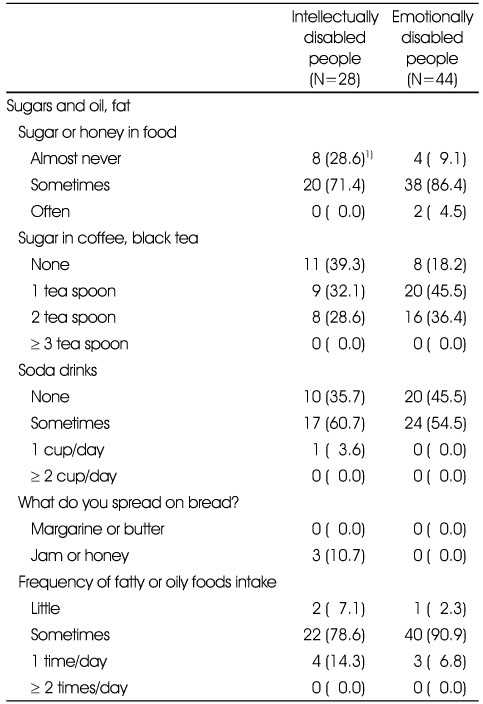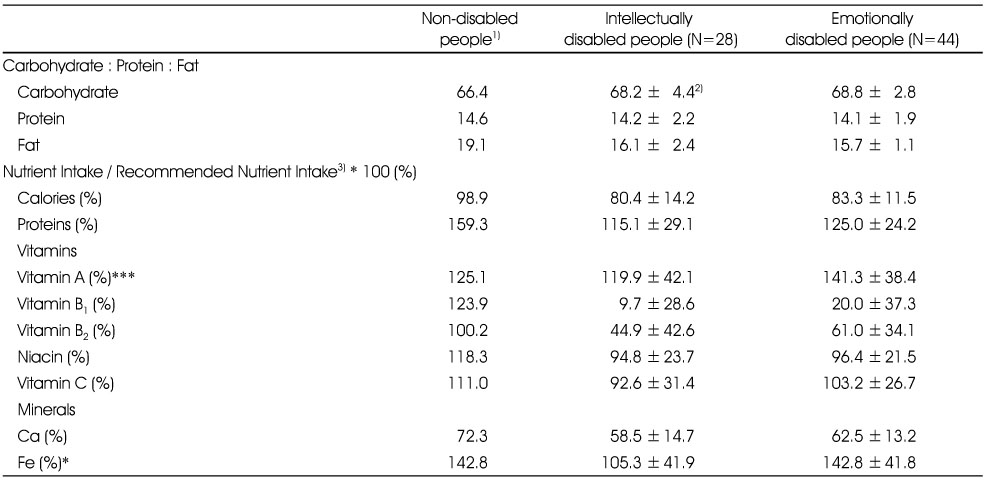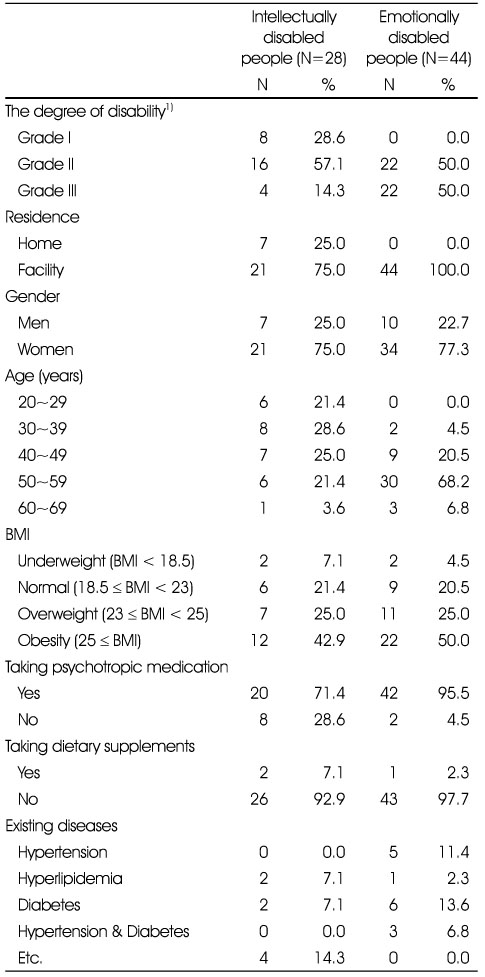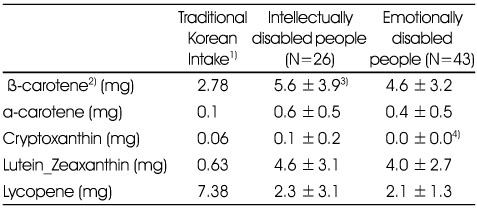Articles
- Page Path
- HOME > Korean J Community Nutr > Volume 20(3); 2015 > Article
-
Research Article
- Nutrient and Carotenoid Intakes and Dietary Habits in Mentally Disabled Adults
- Mi Yeon Ahn, Hwang woon Moon, Hae Yun Chung, Yoo Kyoung Park
-
Korean Journal of Community Nutrition 2015;20(3):208-219.
DOI: https://doi.org/10.5720/kjcn.2015.20.3.208
Published online: June 30, 2015
1Department of Medical Nutrition, Graduate School of East-West Medical Science, Kyung Hee University, Yongin, Korea.
2Department of Sports and Outdoors, Eulji University, Seongnam, Korea.
3Department of Food and Nutrition, Soongeui Women's College, Seoul, Korea.
- Corresponding author: Yoo Kyoung Park. Department of Medical Nutrition, Graduate School of East-West Medical Science, Kyung Hee University, Yongin, Gyeonggi 446-701, Korea. Tel: (031) 201-3816, Fax: (031) 203-3816, ypark@khu.ac.kr
Copyright © 2015 The Korean Society of Community Nutrition
This is an Open-Access article distributed under the terms of the Creative Commons Attribution Non-Commercial License (http://creativecommons.org/licenses/by-nc/3.0/) which permits unrestricted non-commercial use, distribution, and reproduction in any medium, provided the original work is properly cited.
- 955 Views
- 11 Download
- 1 Crossref
Abstract
-
Objectives
- According to preceding studies, many people with mental disability have unbalanced dietary habits or excessive intake of calories. Most of them are overweight or obese due to lack of self-control for food consumption, swallowing with inadequate chewing and physical inactivity. Therefore, this study aimed to assess the nutritional intake, including carotenoid, in mentally disabled people and find out a possible solution for nutritional improvement.
-
Methods
- People with intellectual disability (N=28), emotional disability (N=44) participated in this study. The disorder grades were from I to III and ages were between 20 and 65 years. Assessments included anthropometry, daily intake of nutrients, including carotenoid, ROMA III questionnaire for assessing bowel movement.
-
Results
- The average BMI of intellectually disabled people and emotionally disabled people was in the range of overweight and obesity respectively (23.7 ± 6.3 kg/m2, 25.8 ± 4.1 kg/m2). Overall, the frequencies of vegetable and dairy product intakes were lower in this population. When compared with Recommended Nutrient Intake (RNI) from Dietary Reference Intakes for Koreans 2010, the intakes of vitamin B1, vitamin B2 and calcium were insufficient in both groups. Also, lycopene intakes of carotenoid were low, compared with traditional Korean diet of the non-disabled people from the second year 2008 of the 4th National Health and Nutrition Survey. In addition, emotionally disabled people also had lower intake of cryptoxanthin.
-
Conclusions
- The mentally disabled people in this study showed lower intakes of vitamin B1, vitamin B2, calcium and carotenoids. Based on these findings, we recommend that it is important to encourage mentally disabled people to consume sufficient amounts of such nutrients in order to promote nutritional status.
- 1. Ministry of Health and Welfare. The survey of disabled people [Internet]. 2012; cited 2013 Jul 1]. Available from: http://stat.mw.go.kr/.
- 2. Ministry of Health and Welfare. The Epidemiological Survey of Mental Disorders in Korea [Internet]. 2012; cited 2013 Jul 1]. Available from: https://www.mw.go.kr/.
- 3. Ministry of Health and Welfare. Disability Criteria [Internet]. 2013; cited 2013 Jul 1]. Available from: https://www.mw.go.kr/.
- 4. Chang NS, Kim YS, Kim KN. Foodservice management in institutions for the disabled in Korea. Korean J Diet Cult 2001; 16(2): 187-193.
- 5. Park EJ, Moon HK, Lee SS, Park WH. A study on the food habit and nutritional status of developmentally disabled children. Korean J Nutr 2001; 34(2): 188-197.
- 6. Kwon JS, Lee HS. Nutrient intakes and the physical activities of the mentally retarded persons according to the degree of handicap who were accommodated in institutions in Andong area. Korean J Community Nutr 2007; 12(6): 790-797.
- 7. Yang JS. Dietary behaviors, food preferences and physical activity of the mentally disabled residents in welfare institutes [master's thesis]. Wonkwang University; 2011.
- 8. Park YS, Park KS, Kim CI. Eating behaviors and food preferences of mentally retarded children according to the degree of their handicap. Korean J Community Nutr 2002; 7(5): 628-638.
- 9. Kim EK, An SY, Kim EM, Huh KJ, Kim EK. A comparison of the eating habits and eating behaviors of disabled and non-disabled children. Korean J Community Nutr 2003; 8(6): 840-855.
- 10. Yeom MJ. The comparison of fatness between mentally retarded students and mentally normal students [master's thesis]. Daegu University; 2004.
- 11. The Korean Nutrition Society. Phytonutrient Nutrition. 1st ed. Seoul: Life Science; 2011. p. 257-267.
- 12. Morad M, Nelson N, Merrick J, Davidson PW, Carmeli E. Prevalence and risk factors of constipation in adults with intellectual disability in residential care centers in Israel. Res Dev Disabil 2007; 28(6): 580-586.ArticlePubMed
- 13. Lee HD. A study on food habits, food attitudes and food preferences of children with mental retardation at home [master's thesis]. Yosu National University; 2006.
- 14. The Korean Society of Community Nutrition. The Nutritional Status [Internet]. 2010; cited 2013 Jul 1]. Available from: http://www.dietnet.or.kr/.
- 15. The Korean Nutrition Society. Dietary Reference Intakes For Koreans [Internet]. 2010; cited 2013 Jul 1]. Available from: http://www.kns.or.kr/.
- 16. Kim SH, Cho SW, Hwang SS, Ahn Mj, Lee DH, Kang SW. Increased whole grain, fruits and vegetable intake reduced oxidative stress in high school students. Korean J Nutr 2012; 45(5): 452-461.Article
- 17. Thompson WG, Longstreth GF, Drossman DA, Heaton KW, Irvine EJ, Muller-Lissner SA. Functional bowel disorders and functional abdominal pain. Gut 1999; 45(II): 43-47.Article
- 18. Kim DS, Nho HN, Kim CR, Lee HW, Yoon JH, Uhm JH. Diagnosis of functional gastrointestinal disorders with Rome III criteria in Korean pediatric and adolescent patients: Clinical usefulness of QPGS. Korean J Pediatr Gastroenterol Nutr 2009; 12(2): 120-132.ArticlePDF
- 19. Silva R, Silva GP. Anthropometric and nutritional characteristics of mentally disabled persons. Fit Perf J 2009; 8(2): 130-135.Article
- 20. Hsieh K, Rimmer JH, Heller T. Obesity and associated factors in adults with intellectual disability. J Intellect Disabil Res 2014; 58(9): 851-863.ArticlePubMedPDF
- 21. Togo P, Osler M, Sorensen TI, Heitmann BL. Food intake patterns and body mass index in observational studies. Int J Obes 2001; 25(12): 1741-1751.ArticlePDF
- 22. Malik VS, Schulze MB, Hu FB. Intake of sugar-sweetened beverages and weight gain: a systematic review. Am J Clin Nutr 2006; 84(2): 274-288.ArticlePubMed
- 23. Sohler N, Lubetkin E, Levy J, Soghomonian C, Rimmerman A. Factors associated with obesity and coronary heart disease in people with intellectual disabilities. Soc Work Health Care 2009; 48(1): 76-89.ArticlePubMed
- 24. Haveman M, Heller T, Lee L, Maaskant M, Shooshtari S, Strydom A. Major health risks in aging persons with intellectual disabilities: An overview of recent studies. J Policy Pract Intellect Disabil 2010; 7(1): 59-69.Article
- 25. Hong HS, Lee HY, Cheon MK, Gong HS, Song SE, Le KD, et al. Study on chronic disease prevention and management of disabled people [Internet]. National Rehabilitation Center; 2011; updated 2014 Dec 26]. cited 2013 Jul 1]. Available from: http://www.nrc.go.kr/nrc/data/data01View.jsp?no=14171&menu_cd=M_04_08&fno=37&depart_no=&depart=&part_no=&pg=3&search_item=0&search_content=/.
- 26. Seo HC. The relationship between sugar intake and emotional function of adolescent. J Brain Educ 2013; 11(1): 75-97.
- 27. The Korean Nutrition Society. Phytonutrient. 1st ed. Paju: Dulnyuok; 2013. p. 18-55.
- 28. Adolfsson P, Sydner YM, Fjellström C, Lewin B, Andersson A. Observed dietary intake in adults with intellectual disability living in the community. Food Nutr Res 2008; 52: 1-7.Article
- 29. Ministry of Health and Welfare. Korea Center for Disease Control and Prevention. Korea National Health and Nutrition Examination Survey [Internet]. 2012; cited 2013 Jul 1]. Available from: https://knhanes.cdc.go.kr/.
- 30. Choi HM. Nutrition. 4th ed. Paju: Kyomunsa; 2011. p. 133. p. 235-242.
- 31. Lembo A, Cammilleri M. Chronic constipation. N Engl J Med 2003; 349(14): 1360-1368.ArticlePubMed
- 32. Talley N, Jones M, Nuyts G, Dubois D. Risk factors for chronic constipation based on a general practice sample. Am J Gastroenterol 2003; 98(5): 1107-1111.ArticlePubMed
- 33. Böhmer CJ, Taminiau JA, Klinkenberg-Knol EC, Meuwissen SG. The prevalence of constipation in institutionalized people with intellectual disability. J Intellect Disabil Res 2001; 45(3): 212-218.ArticlePubMed
REFERENCES
The intake frequencies of meat, fish, eggs and beans in subjects with intellectual or emotional disabilities

The intake frequencies of vegetables and fruits in subjects with intellectual or emotional disabilities

The intake frequencies of milk and dairy products in subjects with intellectual or emotional disabilities

The intake frequencies of sugars, and oil fat in subjects with intellectual or emotional disabilities

The nutrients intake of subjects with intellectual or emotional disabilities compared with that of the non-disabled people

1) The nutrient intake of the non-disabled people from the second year 2011 of the 5th National Health and Nutrition Survey
2) Mean ±SD
3) Recommended Nutrient Intake: Dietary Reference Intake For Koreans 2010
*: P < 0.05, **: P < 0.01, ***: P < 0.001 significantly different between intellectually disabled people and emotionally disabled people by two-independent samples t-test
Figure & Data
REFERENCES
Citations

- Factors associated with nutritional risk among disabled persons in the Republic of Korea: a cross-sectional study using 2020 Disability and Life Dynamics Panel
Seong-Ah Kim, Seul Ki Choi
Korean Journal of Community Nutrition.2025; 30(5): 364. CrossRef

Fig. 1
The general information of subjects with intellectual or emotional disabilities
1) The degree of disability; Disabled Welfare Act rules, such as Article 2 and Article 2 Paragraph (2) ⌜Disability Criteria⌟ by The Ministry of Health and Welfare Notification No. 2013-56
The intake frequency of grain in subjects with intellectual or emotional disabilities
1) 1 serving size of staple meals: 1 bowl of rice (210 g), 2 slices of bread (100 g), 1 bowl of Noodle (300 g)
2) N (%)
3) 1 serving size of potato and sweet potato : one potato (130 g), 1/2 sweet potato (90 g)
The intake frequencies of meat, fish, eggs and beans in subjects with intellectual or emotional disabilities
1) 1 serving size of Meat, fish, eggs and beans: One small piece of fish (50 g), meat 60 g, 1 piece of chicken (60 g), one egg (50 g)
2) N (%)
The intake frequencies of vegetables and fruits in subjects with intellectual or emotional disabilities
1) 1 serving size of vegetables: 1 dish of vegetable (70 g), 1 dish of kimchi (40 g)
2) N (%)
3) 1 serving size of fruits: 1/2 apple, 1/4 pears, one tangerine, ten strawberries, 1/2 melon, 1 slice of watermelon, one tomato
The intake frequencies of milk and dairy products in subjects with intellectual or emotional disabilities
1) 1 serving size of milk: 1 cup (200 ml)
2) N (%)
3) 1 serving size of dairy products: 1 slice of cheese (20 g), yogurt 1/2 cup (110 g), ice cream 1/2 cup (100 g)
The intake frequencies of sugars, and oil fat in subjects with intellectual or emotional disabilities
1) N (%)
The nutrients intake of subjects with intellectual or emotional disabilities compared with that of the non-disabled people
1) The nutrient intake of the non-disabled people from the second year 2011 of the 5th National Health and Nutrition Survey
2) Mean ±SD
3) Recommended Nutrient Intake: Dietary Reference Intake For Koreans 2010
*: P < 0.05, **: P < 0.01, ***: P < 0.001 significantly different between intellectually disabled people and emotionally disabled people by two-independent samples t-test
The carotenoid or subjects with intellectual disabilities and emotional disabilities
1) Traditional Korean Intake: Diet analyses from the second year 2008 of the 4th National Health and Nutrition Survey
2) β-carotene : all β-carotene, 9-β-carotene
3) Mean ±SD
4) Cryptoxanthin intake of emotionally disabled subjects : 0.03 ± 0.03
1) The degree of disability; Disabled Welfare Act rules, such as Article 2 and Article 2 Paragraph (2) ⌜Disability Criteria⌟ by The Ministry of Health and Welfare Notification No. 2013-56
1) 1 serving size of staple meals: 1 bowl of rice (210 g), 2 slices of bread (100 g), 1 bowl of Noodle (300 g) 2) N (%) 3) 1 serving size of potato and sweet potato : one potato (130 g), 1/2 sweet potato (90 g)
1) 1 serving size of Meat, fish, eggs and beans: One small piece of fish (50 g), meat 60 g, 1 piece of chicken (60 g), one egg (50 g) 2) N (%)
1) 1 serving size of vegetables: 1 dish of vegetable (70 g), 1 dish of kimchi (40 g) 2) N (%) 3) 1 serving size of fruits: 1/2 apple, 1/4 pears, one tangerine, ten strawberries, 1/2 melon, 1 slice of watermelon, one tomato
1) 1 serving size of milk: 1 cup (200 ml) 2) N (%) 3) 1 serving size of dairy products: 1 slice of cheese (20 g), yogurt 1/2 cup (110 g), ice cream 1/2 cup (100 g)
1) N (%)
1) The nutrient intake of the non-disabled people from the second year 2011 of the 5th National Health and Nutrition Survey 2) Mean ±SD 3) Recommended Nutrient Intake: Dietary Reference Intake For Koreans 2010 *: P < 0.05, **: P < 0.01, ***: P < 0.001 significantly different between intellectually disabled people and emotionally disabled people by two-independent samples t-test
1) Traditional Korean Intake: Diet analyses from the second year 2008 of the 4th National Health and Nutrition Survey 2) β-carotene : all β-carotene, 9-β-carotene 3) Mean ±SD 4) Cryptoxanthin intake of emotionally disabled subjects : 0.03 ± 0.03

 KSCN
KSCN




 Cite
Cite


